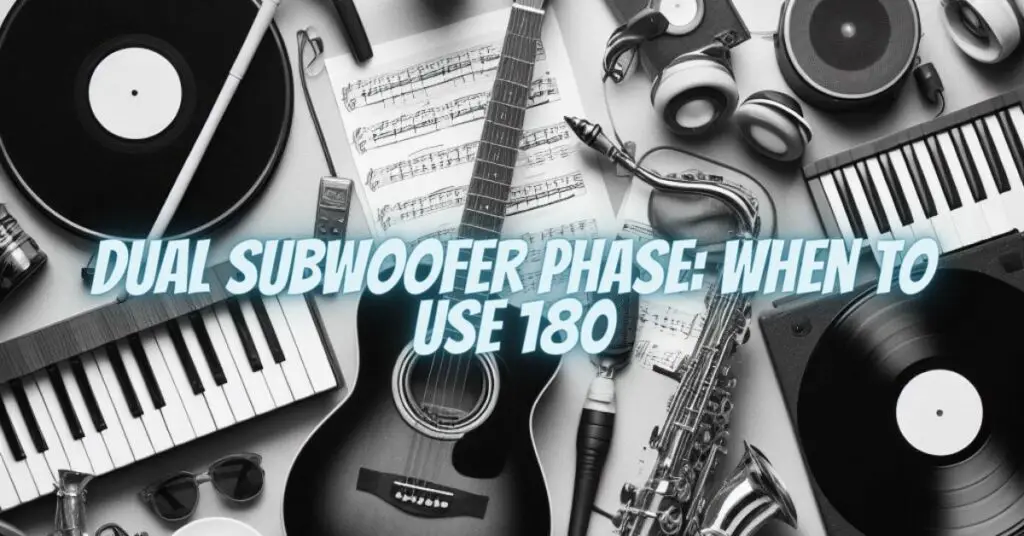When setting up a dual subwoofer system in your audio or home theater setup, one of the key considerations is the phase relationship between the two subwoofers. Phase, measured in degrees, determines whether the two subwoofers are synchronized (0 degrees) or in opposition (180 degrees) with each other. The phase setting can have a significant impact on the overall sound quality and bass performance of your audio system. In this article, we will explore the concept of dual subwoofer phase and discuss the pros and cons of both 0 degrees and 180 degrees settings.
Understanding Dual Subwoofer Phase
Before delving into the debate of whether to set dual subwoofers to 0 or 180 degrees, it’s essential to grasp the concept of phase in this context. Subwoofers produce low-frequency bass sounds that can either align perfectly in-phase (0 degrees) or be intentionally set out-of-phase (180 degrees) with each other.
0 Degrees (In-Phase)
In-phase configuration means that the subwoofers operate in synchrony, moving in and out simultaneously. When set to 0 degrees, dual subwoofers produce a stronger and more impactful bass response. This setting is ideal for creating a deep and full bass experience that is uniform throughout the listening area. In-phase subwoofers tend to work together seamlessly and result in a more cohesive and powerful bass presentation.
180 Degrees (Out-of-Phase)
Setting subwoofers to 180 degrees out-of-phase means that one subwoofer’s motion is reversed in relation to the other. This configuration can be useful in specific scenarios, particularly when dealing with issues such as phase cancellation. In some instances, two subwoofers operating out-of-phase can reduce problematic room resonances and improve bass clarity. However, it is essential to use this setting cautiously, as it can lead to a less cohesive and weaker bass response when not used correctly.
Pros and Cons of 0 Degrees
Pros:
- Strong, uniform bass response.
- Improved bass impact and depth.
- A more cohesive and immersive listening experience, especially in larger rooms.
Cons:
- May not address room-related bass issues, such as resonances.
- May require careful positioning and calibration for optimal results.
Pros and Cons of 180 Degrees
Pros:
- Can help address phase cancellation and room resonances.
- Useful for specific scenarios where in-phase subwoofers create problems.
Cons:
- Typically results in a weaker, less impactful bass response.
- May lead to a less immersive audio experience, especially in larger rooms.
When to Use 0 or 180 Degrees for Dual Subwoofers
The choice between 0 degrees and 180 degrees for dual subwoofers depends on several factors, including room size, room acoustics, subwoofer placement, and personal preferences:
- 0 Degrees (In-Phase): This is the preferred setting for most audio and home theater setups. It is ideal for creating a deep, impactful bass that is consistent throughout the listening area. Use 0 degrees when you want a powerful, immersive bass experience.
- 180 Degrees (Out-of-Phase): Use the 180-degree setting when you face specific issues related to phase cancellation or room resonances that cannot be resolved through other means. Be cautious when employing this setting, as it can result in a weaker bass response.
Calibration and Testing
To determine the optimal phase setting for your dual subwoofer system, it’s crucial to calibrate and test the setup thoroughly. This may involve using a sound level meter, test tones, and room measurement tools to ensure that the subwoofers are working together effectively and addressing any room-related issues. Experimentation and adjustments are key to finding the right phase setting for your specific room and audio system.
In conclusion, the decision to set your dual subwoofers to 0 or 180 degrees ultimately depends on your room’s acoustics, the specific challenges you’re facing, and your audio preferences. While in-phase subwoofers generally deliver a more powerful and immersive bass experience, there are situations where an out-of-phase configuration can be a valuable tool for addressing specific room-related issues. Careful calibration and testing will help you determine the ideal phase setting for your dual subwoofer system, ensuring that you enjoy the best possible bass performance in your audio or home theater setup.


